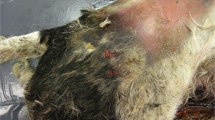Abstract
In a case of negative human-leopard (Panthera pardus) interaction, an animal was burnt alive in South Rajasthan, India. We identified the species and sex of the victim animal from the ash using forensic DNA analysis. We recovered three objects (half burnt clot, stone, and shrub twig) from the ash having suspected blood stains. We extracted DNA from these items and amplified a partial fragment of mitochondrial DNA cytochrome b and 12S RNA genes. The sequence generated from these amplicons suggested that the victim animal was a leopard. Furthermore, amplification of a fragment of SRY (224 bp) and ZFX/Y (442 bp) genes indicated that the blood clot was of a male leopard. Although attempts have been made to remove every possible evidence from the crime scene, the species and sex of the victim animal were determined from the challenging and invisible blood stains wrapped in the ash.


Similar content being viewed by others
References
Stein AB, Athreya V, Gerngross P, Balme G, Henschel P, Karanth U, Miquelle D, Rostro-Garcia S, Kamler JF, Laguardia A, Khorozyan I, Ghoddousi A (2016) Panthera pardus. (errata version published in 2016) The IUCN red list of threatened species 2016: e.T15954A102421779. Downloaded on 14 Feb 2017
Krishna PH, Reddy CS (2012) Assessment of increasing threat of forest fires in Rajasthan, India using multi-temporal remote sensing data (2005–2010). Current Sci 102:1288–1297
Mitra S (2005) Gir forests and the Saga of the Asiatic lion. Indus Publishing. ISBN 8173871833, 9788173871832
Gupta SK, Kumar A (2014) Molecular identification of man-eating carnivores from scat samples. Conserv Genet Resour 6:271–274
Tobe SS, Kitchener AK, Linacre AMT (2010) Reconstructing mammalian phylogenies: a detailed comparison of the cytochrome b and cytochrome oxidase subunit I mitochondrial genes. PLoS One 5:e14156
Verma SK, Singh L (2003) Novel universal primers establish identity of enormous number of animal species for forensic application. Mol Ecol Notes 3:28–31
Wasser SK, Houston CS, Koehler GM, Cadd GG, Fain SR (1997) Techniques for amplification of fecal DNA methods to field studies of Ursids. Mol Ecol 6:1091–1097
Kocher TD, Thomas WK, Meyer A, Edwards SV, Paabo S, Villablanca FX, Wilson AC (1989) Dynamics of mitochondrial DNA evolution in animals: amplification and sequencing with conserved primers. Proc Natl Acad Sci U S A 86:6196–6200
Altschul SF, Madden TL, Schaffer AA, Zhang J, Zhang Z, Miller W, Lipman J (1997) Gapped BLAST and PSIBLAST: a new generation of protein database search programs. Nucleic Acids Res 25:3389–3402
Thompson JD, Higgins DG, Gibson TJ (1994) CLUSTAL W: improving the sensitivity of progressive multiple sequence alignment through sequence weighting, position-specific gap penalties and weight matrix choice. Nucleic Acids res 22:4673–4680
Kumar S, Stecher G, Tamura K (2016) MEGA7: molecular evolutionary genetics analysis version 7.0. Mol Biol Evol 33:1870–1874. doi:10.1093/molbev/msw054
Gupta SK, Verma SK, Singh L (2005) Molecular insight into a wildlife crime: the case of a peafowl slaughter. Forensic Sci Int 154:214–217
Gupta SK, Kumar A, Hussain SA, Vipin, Singh L (2013) Cytochrome b based genetic differentiation of Indian wild pig (Sus scrofa cristatus) and domestic pig (Sus scrofa domestica) and its use in wildlife forensics. Sci Justice 53:220–222
Acknowledgements
This study was funded by the Wildlife Institute of India (WII). The support provided by the Director, the Dean, and Dr. Y.V. Jhala, Nodal Officer, Forensic Cell, WII, are acknowledged. The authors thank Sh. Anil Rodger, Udaipur News, for providing information regarding the human-wildlife conflict in Rajasthan. The forest departments of the State of Rajasthan acknowledged for sending the ash from the crime scene for forensic investigation.
Author information
Authors and Affiliations
Corresponding author
Rights and permissions
About this article
Cite this article
Vipin, Sharma, V. & Gupta, S.K. Molecular identification of victim species and its sex from the ash: a case of burning alive leopard (Panthera pardus). Int J Legal Med 132, 1075–1078 (2018). https://doi.org/10.1007/s00414-017-1619-1
Received:
Accepted:
Published:
Issue Date:
DOI: https://doi.org/10.1007/s00414-017-1619-1




